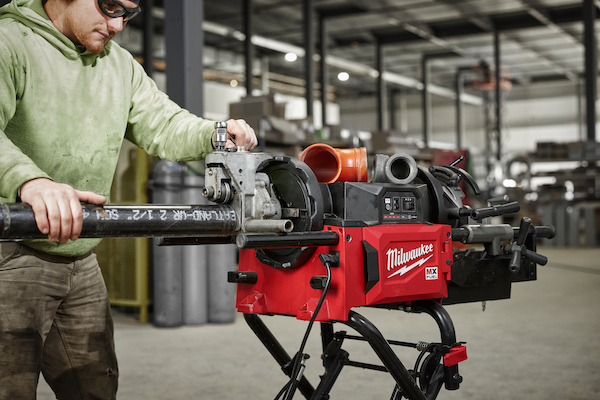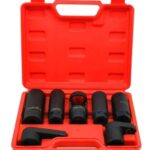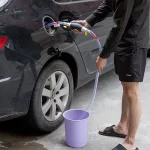A pipe threader is a specialized tool used to create screw threads on the ends of pipes, allowing them to be connected securely using threaded fittings. The primary purpose of a pipe threader is to facilitate the assembly and installation of piping systems in various industries, such as plumbing, construction, oil and gas, and manufacturing.
Pipe threaders typically consist of several key components:
- Threading Die: This is the main component responsible for cutting the threads onto the pipe. The threading die is a hardened steel ring with internal grooves or teeth that correspond to the desired thread pattern.
- Die Head: The die head holds the threading die in place and allows it to rotate around the pipe. It is designed to apply the necessary pressure and alignment for accurate thread cutting.
- Drive Mechanism: This component provides the rotational force to turn the die head and threading die around the pipe. It can be manual, such as a hand-operated crank or ratchet mechanism, or powered by an electric or pneumatic motor.
- Pipe Clamp or Vise: This component securely holds the pipe in place during the threading process, preventing it from rotating or moving.
- Cutting Compound or Lubricant: A specialized cutting compound or lubricant is applied to the pipe surface to improve the cutting action, reduce friction, and extend the life of the threading die.
The basic operation involves clamping the pipe securely, applying the cutting compound, and then rotating the threading die around the pipe end using the drive mechanism. As the die rotates, it progressively cuts the threads into the pipe material, creating a precise and uniform thread pattern.
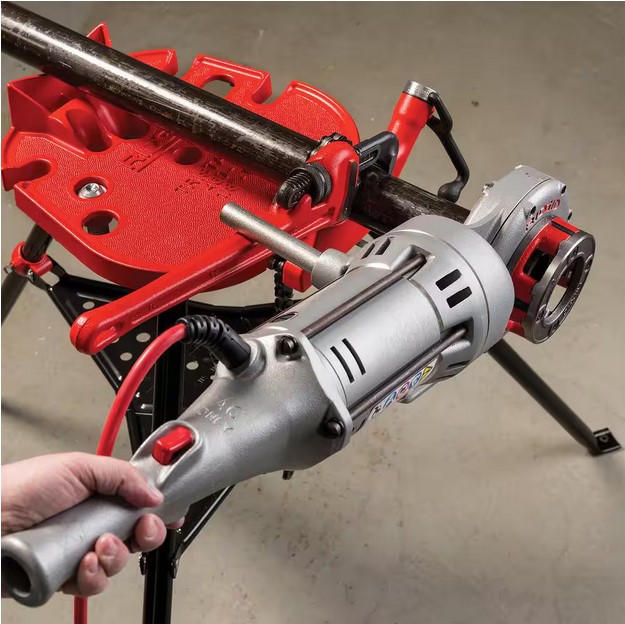
Table of Contents
Types of Pipe Threaders
Pipe threaders are available in various types to cater to different job requirements, pipe sizes, and power sources. The main types include:
Manual Pipe Threaders: These are hand-operated tools, typically used for threading smaller diameter pipes. They consist of a die head, handle, and a sturdy frame or base. Manual pipe threaders are portable, lightweight, and require physical effort to operate, making them suitable for on-site or remote work.
Power-Driven Pipe Threaders: These threaders are powered by electric motors or pneumatic systems, offering greater speed and efficiency compared to manual models. Power-driven threaders are available in various sizes and capacities, ranging from compact, portable units to large, industrial-grade machines capable of threading pipes with diameters up to several inches.
Bench-Top Pipe Threaders: As the name suggests, these threaders are designed to be mounted on a workbench or table. They are typically used for threading smaller pipes and are suitable for workshops, repair shops, or light industrial settings.
Floor-Standing Pipe Threaders: These are heavy-duty, industrial-grade threaders designed for high-volume production or threading larger diameter pipes. Floor-standing pipe threaders are commonly found in manufacturing facilities, construction sites, and oil and gas industries.
Portable Pipe Threaders: These compact and lightweight threaders are designed for easy transportation and on-site use. They are often battery-powered or pneumatic, making them suitable for remote locations or areas without access to electricity.
Pipe threaders also vary in terms of their capacity, with some models capable of threading pipes ranging from 1/4 inch to 6 inches or more in diameter. The choice of pipe threader depends on factors such as the size and material of the pipes, the required threading speed, and the intended application or work environment.
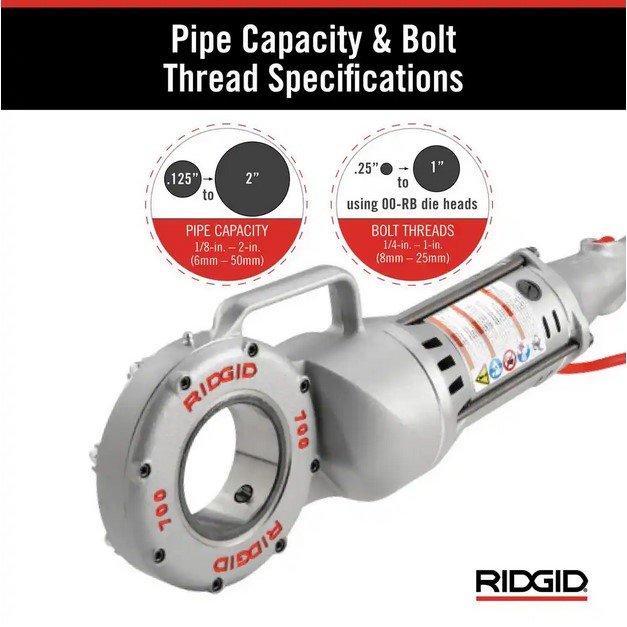
Working Principle and Operation
A pipe threader is a specialized machine tool designed to create precise threads on the ends of metal pipes. The threading process involves cutting spiral grooves into the pipe’s surface, allowing it to securely connect with compatible fittings and other threaded components.
The core working principle of a pipe threader revolves around the coordinated rotation of the pipe and the cutting tool. The pipe is secured in a chuck or clamping mechanism, ensuring it remains stationary during the threading operation. Simultaneously, a cutting head containing hardened steel dies or chasers rotates around the pipe’s end.
As the cutting head spins, the dies gradually advance towards the pipe, engaging the surface and removing material in a controlled manner. Each die is meticulously designed with a specific thread profile, ensuring the threads cut into the pipe match the desired standard, such as NPT (National Pipe Thread) or BSPT (British Standard Pipe Thread).
Pipe preparation is crucial for achieving accurate and consistent threading results. Before commencing the threading process, the pipe’s end must be properly squared and deburred. This step ensures that the cutting dies engage the pipe evenly, preventing uneven thread formation or potential binding during assembly.
Some pipe threaders incorporate additional features like automatic pipe centering mechanisms, coolant systems, and adjustable die positioning to accommodate different pipe sizes and thread specifications. Advanced models may also offer digital controls and monitoring systems for enhanced precision and repeatability.
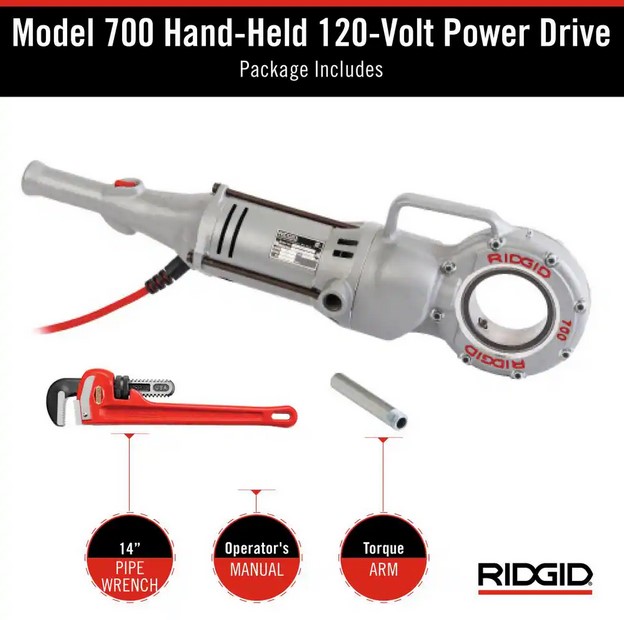
Applications and Uses
Pipe threaders are essential tools used in various industries for creating threaded connections on pipes. Their applications span across several sectors, including plumbing, construction, oil and gas, and manufacturing.
Plumbing: In the plumbing industry, pipe threaders are indispensable for joining pipes and fittings used in water supply lines, drainage systems, and gas lines. Plumbers rely on pipe threaders to create threads on pipes made of materials such as copper, galvanized steel, and PVC, ensuring secure and leak-proof connections.
Construction: The construction industry heavily depends on pipe threaders for installing piping systems in residential, commercial, and industrial buildings. These tools are used to thread pipes for various applications, including HVAC systems, fire sprinkler systems, and piping for compressed air or other utilities.
Oil and Gas Industry: Pipe threaders play a crucial role in the oil and gas industry, where they are used to create threaded connections for pipelines, wellheads, and other equipment. The harsh environmental conditions and high-pressure requirements in this industry necessitate the use of robust pipe threaders capable of handling large-diameter pipes made of materials like carbon steel and stainless steel.
Manufacturing: In manufacturing facilities, pipe threaders are essential for installing and maintaining piping systems used for transporting fluids, gases, or other materials. They are employed in industries such as chemical processing, food and beverage production, and pharmaceutical manufacturing, where piping systems must meet stringent safety and hygiene standards.
Pipe threaders are versatile tools that enable secure and reliable connections in various applications, ensuring the efficient and safe transportation of liquids, gases, and other materials through piping systems.
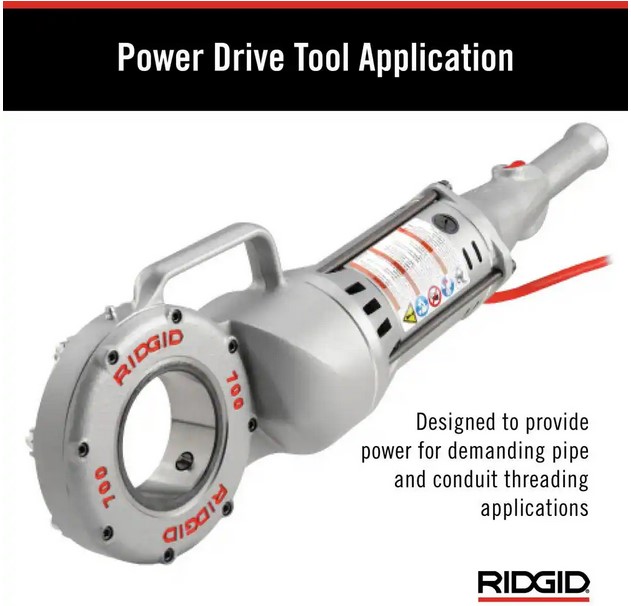
Choosing the Right Pipe Threader
Selecting the appropriate pipe threader is crucial for ensuring efficient and accurate pipe threading operations. Several factors must be considered to make an informed decision:
Pipe Size: Pipe threaders are designed to accommodate specific pipe diameter ranges. It’s essential to choose a machine that can handle the sizes of pipes required for your project. Attempting to thread pipes outside the designated size range can lead to poor thread quality, increased wear on the equipment, and potential safety hazards.
Pipe Material: Different pipe materials, such as steel, stainless steel, copper, or plastic, may require specific threading techniques or tools. Some pipe threaders are better suited for certain materials than others. Ensure that the machine you select is compatible with the pipe material you’ll be working with to achieve optimal results and avoid excessive wear or damage.
Project Requirements: Consider the scope and nature of your pipe threading projects. If you frequently work on large-scale industrial or commercial projects, you may need a heavy-duty, high-capacity pipe threader capable of handling extended periods of operation. For smaller residential or maintenance tasks, a more compact and portable threader might be more suitable.
Additionally, evaluate the required thread types (e.g., NPT, BSPT, or other standards) and the need for additional features like automatic oiling systems, quick-change die heads, or built-in safety mechanisms. Matching the pipe threader’s capabilities to your project requirements will ensure efficient and accurate threading while minimizing downtime and rework.
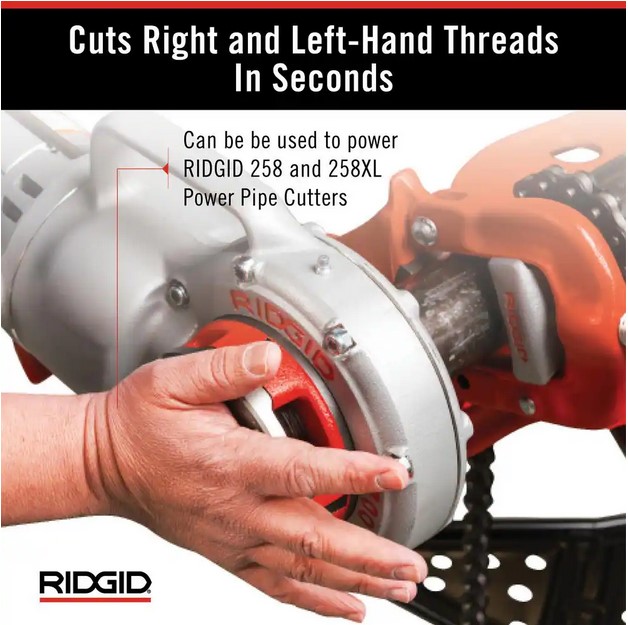
Safety Precautions
Pipe threading is a process that involves rotating sharp cutting tools at high speeds, which can pose significant safety risks if proper precautions are not taken. To ensure the safety of operators and those around the work area, it is crucial to follow these guidelines:
Proper Handling and Operation
- Always read and follow the manufacturer’s instructions for safe operation and maintenance.
- Ensure that the pipe threader is securely mounted or placed on a stable surface to prevent movement during operation.
- Keep the work area clean and free from clutter, which could cause tripping hazards or interfere with the operation.
- Never operate the pipe threader while under the influence of drugs, alcohol, or medication that may impair your judgment or reaction time.
Maintenance and Inspection
- Regularly inspect the pipe threader for any signs of wear, damage, or loose components, and address any issues promptly.
- Keep the cutting tools sharp and in good condition to prevent binding or kickback.
- Lubricate and clean the machine according to the manufacturer’s recommendations to ensure smooth operation and prolong its lifespan.
Personal Protective Equipment (PPE)
- Always wear appropriate PPE, including safety glasses or a face shield to protect your eyes from flying debris or chips.
- Wear sturdy, non-slip footwear to maintain proper footing and avoid slips or falls.
- Use protective gloves to prevent cuts or abrasions from handling sharp cutting tools or hot workpieces.
- Wear hearing protection, such as earplugs or earmuffs, to safeguard your hearing from the noise generated during pipe threading operations.
By adhering to these safety precautions, you can significantly reduce the risk of accidents and injuries while operating a pipe threader. Remember, prioritizing safety should be an integral part of every pipe threading task.
Maintenance and Troubleshooting
Proper maintenance and troubleshooting are crucial for ensuring the longevity and efficient operation of a pipe threader. Regular cleaning and lubrication can prevent premature wear and tear, while addressing common issues can help avoid costly downtime and repairs.
Cleaning
Keeping the pipe threader clean is essential for its smooth operation and prolonged lifespan. After each use, it is recommended to remove any debris, metal shavings, or other contaminants from the machine’s components. Pay special attention to the die head, guide bushings, and lead screw, as these parts are particularly susceptible to buildup and wear.
Lubrication
Lubrication is vital for reducing friction and wear on the moving parts of the pipe threader. Follow the manufacturer’s recommendations for the type and frequency of lubrication. Typically, a high-quality machine oil or grease should be applied to the lead screw, bushings, and other moving components at regular intervals.
Common Issues and Solutions
- Dull or Damaged Dies: Over time, the dies used for cutting threads can become dull or damaged, resulting in poor thread quality or incomplete cuts. Replace the dies promptly when they show signs of wear or damage.
- Misalignment: If the pipe threader is not properly aligned, it can cause uneven thread cutting and increased wear on the components. Check the alignment regularly and make necessary adjustments according to the manufacturer’s instructions.
- Slippage or Binding: If the pipe slips or binds during threading, it may indicate a lack of lubrication, misalignment, or worn components. Troubleshoot the issue by checking the lubrication, alignment, and condition of the guide bushings and lead screw.
- Motor or Drive Issues: Problems with the motor or drive system can prevent the pipe threader from operating correctly. Inspect the motor, belts, gears, and other drive components for signs of wear or damage, and replace or repair as necessary.
- Safety Concerns: Always address any safety issues promptly, such as frayed power cords, damaged guards, or loose components, to prevent accidents or injuries.
By following proper maintenance and troubleshooting procedures, you can extend the lifespan of your pipe threader, ensure consistent performance, and avoid costly repairs or downtime.
Accessories and Consumables
Pipe threading requires several essential accessories and consumables to ensure efficient and precise operation. These include:
Threading Dies: Threading dies are the heart of the pipe threading process. They come in various sizes and thread pitches to accommodate different pipe diameters and thread specifications. Threading dies are typically made from high-quality tool steel and are precision-ground to ensure accurate thread formation. Regular replacement of worn or damaged dies is crucial to maintain threading quality and consistency.
Cutting Oils: Cutting oils, also known as threading oils, are lubricants specifically formulated to reduce friction, dissipate heat, and enhance chip evacuation during the threading process. These oils not only prolong the life of the threading dies but also improve surface finish and dimensional accuracy. Choosing the appropriate cutting oil based on the material being threaded and the operating conditions is essential.
Support Equipment: In addition to the pipe threader itself, several support equipment items are necessary for efficient pipe threading operations. These may include pipe vises or clamps to securely hold the pipe in place, deburring tools for removing burrs from the pipe ends, thread protectors to safeguard finished threads during transportation or storage, and pipe stands or rollers to support longer pipe lengths during the threading process.
Regular maintenance and timely replacement of consumables, such as threading dies and cutting oils, are crucial to ensure consistent threading quality, extend equipment life, and maintain a safe and productive work environment.
Industry Standards and Regulations
Pipe threading is a critical process in various industries, and as such, it is subject to several industry standards and regulations to ensure safety, quality, and consistency. These standards and regulations are established by recognized organizations and governing bodies to maintain uniformity and compliance across different applications and sectors.
One of the most widely recognized standards for pipe threading is the American National Standard Taper Pipe Thread (NPT) developed by the American National Standards Institute (ANSI). This standard specifies the dimensions, tolerances, and thread forms for tapered pipe threads used in piping systems for various fluids, gases, and materials. Adherence to the ANSI NPT standard ensures compatibility and interchangeability between threaded components from different manufacturers.
Another important standard is the British Standard Pipe Thread (BSPT), which is similar to the NPT but with slightly different dimensions and tolerances. This standard is commonly used in the United Kingdom and other regions that follow British standards.
In addition to these general standards, specific industries may have their own regulations and guidelines for pipe threading. For example, the American Petroleum Institute (API) has established standards for pipe threading in the oil and gas industry, ensuring the integrity and safety of piping systems used in exploration, production, and transportation processes.
Similarly, the American Society of Mechanical Engineers (ASME) has developed codes and standards for pipe threading in various applications, including power generation, chemical processing, and construction. These standards cover aspects such as material selection, thread design, and testing requirements to ensure the safe and reliable operation of piping systems.
Compliance with industry standards and regulations is crucial for pipe threading operations. Failure to adhere to these guidelines can result in safety hazards, equipment failures, leaks, and potential legal consequences. Manufacturers, installers, and end-users must ensure that their pipe threading processes and equipment meet the applicable standards and regulations for their specific industry and application.
Environmental Considerations
When it comes to pipe threading operations, environmental considerations play a crucial role in ensuring sustainable practices. Proper waste management and eco-friendly approaches are essential to minimize the environmental impact of these activities.
One of the primary concerns in pipe threading is the generation of metal shavings and chips during the cutting and threading process. These waste materials can be harmful to the environment if not disposed of properly. Implementing effective waste collection and recycling systems is crucial to prevent these materials from ending up in landfills or waterways.
Eco-friendly practices in pipe threading operations can include the use of biodegradable cutting fluids and lubricants. Traditional cutting fluids often contain hazardous chemicals that can contaminate soil and water sources. By opting for environmentally friendly alternatives, companies can reduce their ecological footprint while maintaining optimal performance.
Additionally, manufacturers and users of pipe threading equipment should prioritize energy efficiency. Investing in energy-efficient machinery and implementing practices that minimize energy consumption can significantly reduce the carbon footprint associated with these operations.
Sustainability should also be a key consideration when it comes to the design and manufacturing of pipe threading equipment. Manufacturers can explore the use of recycled materials, implement lean manufacturing processes, and prioritize product durability and longevity. This approach not only reduces waste but also contributes to a circular economy, where resources are reused and recycled rather than discarded.
Furthermore, proper training and education for workers involved in pipe threading operations are essential for promoting environmental awareness and responsible practices. Educating personnel on the importance of waste management, energy conservation, and sustainable practices can foster a culture of environmental stewardship within the industry.
By embracing environmentally conscious practices, the pipe threading industry can contribute to a more sustainable future while meeting the demands of various applications and sectors.
Future Trends and Innovations
The pipe threading industry is poised for significant advancements driven by emerging technologies and automation. One notable trend is the integration of computer numerical control (CNC) systems into pipe threaders. CNC technology allows for precise, automated threading operations, improving efficiency, consistency, and reducing human error.
Another area of innovation is the development of intelligent pipe threaders that leverage artificial intelligence (AI) and machine learning algorithms. These advanced systems can analyze data from sensors and adjust threading parameters in real-time, optimizing the process for different pipe materials, sizes, and threading requirements.
The adoption of additive manufacturing techniques, such as 3D printing, is also gaining traction in the industry. This technology enables the production of custom threading components and tools, reducing lead times and facilitating on-demand manufacturing.
Furthermore, the integration of the Internet of Things (IoT) and cloud computing is transforming pipe threading operations. Connected threaders can transmit data to cloud platforms, enabling remote monitoring, predictive maintenance, and real-time performance analysis. This connectivity also facilitates seamless collaboration and data sharing across multiple job sites or manufacturing facilities.
In terms of industry outlook, the pipe threading market is expected to experience steady growth, driven by increasing demand from sectors such as oil and gas, construction, and water and wastewater management. However, there is a growing emphasis on sustainability and environmentally friendly practices, which may influence the design and manufacturing processes of pipe threaders in the future.
Overall, the pipe threading industry is embracing cutting-edge technologies and automation to enhance efficiency, precision, and versatility, while also addressing environmental concerns and meeting evolving market demands.

